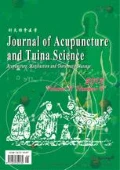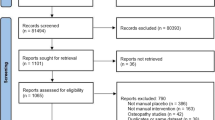Abstract
Tuina is a physical therapy for treatment and prevention of diseases. The predecessors had summed up the systematic tuina manipulations through experiences. In order to study the scientificity and usability of the technology, the researchers established a mathematical model of tuina manipulations, and used video technology to capture the trajectory of the manipulations. Using the mechanical sensor to sense the real manipulations, researchers developed a tuina manipulation instrument and obtained a lot of basic mechanics data about the manipulation technology. Through the summary of the research results of the predecessors, accurate, true and comprehensive mechanical parameters of technology of tuina manipulations were obtained to guide the research and development of instruments of tuina manipulations, and promote the development of the discipline of tuina science.
概要
推拿是一种治疗和预防疾病的物理疗法。 前人在不断的生活积累中总结出了系统的推拿疗法。 为研究推拿的科学性和可用性, 研究人员建立了推拿手法的数学模型, 并利用视频技术捕捉手法轨迹, 利用力学传感器感触真实手法, 研发出了推拿手法检测仪器, 获得大量有关推拿手法的基础力学数据。 通过对前人的研究成果进行总结, 以获得精准、 真实、 全面的推拿手法力学参数, 用于指导推拿诊疗仪器的研发, 促进推拿学科的发展。
Similar content being viewed by others
References
Yuan SQ, Feng T. Encyclopedia of China. Beijing: Huaxia Publishing House, 1990: 992.
Wang XB. Research on the History of Chinese Ancient Tuina and Massage. Harbin: Master Thesis of Heilongjiang University of Chinese Medicine, 2009.
Lü XM. A brief history of folk massage treatment in ancient China. Zhongguo Minjian Liaofa, 2006, 14(8): 3–4.
Li HD. Research on Tuina Ancient Documents. Jinan: Doctor Thesis of Shandong University of Traditional Chinese Medicine, 2006.
Zhao Y. Historic lessons and considerations of ‘Longqing Event’ of massage science. Shanghai Zhongyiyao Daxue Xuebao, 2007, 21(5): 26–28.
Zhao Y. Thinking about the ups and downs of the Ming Dynasty hand medicine. Shanghai: State Conference Colloquia on Different Schools and Literature of Tuina, 2001.
Geng N. Operation Characteristics of Cervical Positionedrotation Ban-pulling Manipulation and Analysis of Its Parameters of Dynamics and Kinematics. Beijing: Master Thesis of Beijing University of Chinese Medicine, 2014.
Min YJ, Wang HS, Yan ZG, Shao SJ. Discussion on the application and research of sensor technology in acupuncture and moxibustion. Shanghai Zhenjiu Zazhi, 2006, 25(12): 27–29.
Chen WJ, Xu SX. Reducing arterial pressure by massaging the carotid sinus: a mathematical model study. Shanghai Shengwu Yixue Gongcheng, 2006, 27(2): 70–73.
Li YK, Chen JH, Qiu GC. Measurement technique for the cracking sounds during spinal manipulation. Diyi Junyi Daxue Xuebao, 2005, 25(4): 419–422.
Hou XK, Dong F, Zhao WC. Study on the threedimensional motion of intact lumbar vertebrae when obliquely pulled. Zhongguo Gushang, 1996, 10(4): 5–7, 63.
Li SH. Research on Some Key Technologies of a Systematic for Synthetical Measurement of Chinese Medical Massage. Hefei: Doctor Thesis of University of Science and Technology of China, 2013.
Suga H. Theoretical analysis of a left-ventricular pumping model based on the systolic time-varying pressure-volume ratio. IEEE Trans Biomed Eng, 1971, 18(1): 47–55.
Zheng TS. Dynamic simulation model and simulation study of cardiovascular system dynamics. Guangdong Jixie Xueyuan Xuebao, 1992, 10(2): 17–24.
Xu SX, Di N, Lü L, Ji L. Analysis of the input impedance of pulsative flow through a vessel with mild stenosis amplitude oscillating radially. Yiyong Shengwu Lixue, 2000, 15(3): 157–161.
Xu SX, Ji L, Chew YT, Lü L, Mao XC. Hemodynamica on pulsatile flow through a vessel with mild stenosis amplitude oscillating radially. Yiyong Shengwu Lixue, 1999, 14(4): 202–207.
Lü L, Xu SX. An analysis of pressure and pressure gradient of pulsation flow through an elastic satraight tube with a mild stenosis amplitude oscillating in radial direction. Yiyong Shengwu Lixue, 1999, 14(3): 144–151.
Cheng WH, Lü L, Xu SX, Chew YT, Low HT, Yan JT, Shen GQ, Sun WQ, Xu J. Flux analysis of an artery with a moving stenosis forced by rolling manipulation. Yiyong Shengwu Lixue, 2003, 18(1): 1–5.
Xu SX, Ji L, Wang QW. Numerical investigation of effect of rolling manipulation of traditional Chinese medical massage on blood flow. Yingyong Shuxue He Lixue, 2005, 26(6): 694–700.
Bi S, Li YK, Zhao WD, Wang AY, Zhang Y, Zhang M, Zhang DW, Wang FG. Comparative study of simulated lumbar manipulation techniques using biomechanical and three-dimensional finite element models. Zhonghua Wuli Yixue Yu Kangfu Zazhi, 2002, 24(9): 16–19.
Li HB. Study of the Blood Flows by Lattice Boltzmann Method. Shanghai: Doctor Thesis of Fudan University, 2004.
Lü XY. Lattice Boltzmann Method Simulations of Blood Flowing in Elastic Tube. Shanghai: Doctor Thesis of Fudan University, 2006.
Jin L, Wang WX, Li HB, Tan HL. Lattice Blotzmann simulation model of rolling massage. Guangxi Shifan Daxue Xuebao (Ziran Kexue Ban), 2009, 27(1): 9–12.
Zhang CQ. Analysis of the Kinematical Feature of 5Kinds of Tuina Manipulations. Beijing: Master Thesis of China Academy of Chinese Medical Sciences, 2009.
Sun WQ, Yan JT. Theoretical and experimental study on the frequency of tuina manipulations. Anmo Yu Daoyin, 2002, 18(5): 2–4.
Yan XH, Yan JT, Gong L, Jiang SY. Study on standardization of tuina manipulation parameters. Shijie Kexue Jishu: Zhongyiyao Xiandaihua, 2015, 17(12): 2443–2450.
Yan XH, Yan JT, Gong L, Jiang SY. Discussion on manipulation classification based on analysis of sports biomechanics. Zhonghua Zhongyiyao Zazhi, 2017, 32(7): 3229–3231.
Klein P, Broers C, Feipel V, Salvia P, Van Geyt B, Dugailly PM, Rooze M. Global 3D head-trunk kinematics during cervical spine manipulation at different levels. Clin Biomech (Bristol, Avon), 2003, 18(9): 827–831.
Ngan JM, Chow DH, Holmes AD. The kinematics and intra-and inter-therapist consistencies of lower cervical rotational manipulation. Med Eng Phys, 2005, 27(5): 395–401.
Meng L. TDL-I type massage force dynamic force tester was successfully developed. Shandong Zhongyi Xueyuan Xuebao, 1982, 6(3): 37.
Zeng QY. The Studies on the Kinetic Biomechanism of the Action Principles of Rolling Manipulation. Jinan: Master Thesis of Shandong University of Traditional Chinese Medicine, 2003.
Wang GC, Bi YS, Zhang SF, Zhou XF, Cheng DM. Determination and application of the dynamic curve of massage manipulation. Shandong Zhongyi Xueyuan Xuebao, 1982, 6(1): 72–76.
Kawchuk GN, Herzog W. Biomechanical characterization (fingerprinting) of five novel methods of cervical spine manipulation. J Manipulative Physiol Ther, 1993, 16(9): 573–577.
Kawchuk GN, Herzog W, Hasler EM. Forces generated during spinal manipulative therapy of the cervical spine: a pilot study. J Manipulative Physiol Ther, 1992, 15(5): 275–278.
Herzog W, Conway PJ, Kawchuk GN, Zhang Y, Hasler EM. Forces exerted during spinal manipulative therapy. Spine (Phila Pa 1976), 1993, 18(9): 1206–1212.
Zhou XW, Xu SX, Xie ZY, Li XA, Chen SJ, Shen YY, Yang JH, Yan JT, Zhao Y, Xu J, Xu CP. Traditional Chinese medical massage manipulation monitor and analysis of resultant acting point locus. Yiyong Shengwu Lixue, 1996, 11(3): 179–183.
Qiu GC. The Measurement of Commonly Used Manipulative Force and Its Clinical Significance. Guangzhou: Master Thesis of Diyi Junyi Daxue, 2005.
Zhu LG, Zhong HG, Feng MS. Rotating manual operation mechanics measuring instrument: CN20072013552. 2008–02–13.
Feng MS. Experimental observation of the effects of mechanical measurement and simulation of the maneuvering method on the internal pressure of the cervical nucleus. Beijing: Master Thesis of China Academy of Chinese Medical Sciences, 2007.
Sun Y, Yin ZN, Xu YJ, Liu F. Research and progress of capacitive flexible tactile sensors. Weina Dianzi Jishu, 2017, 54(10): 684–693.
Shimojo M, Makino R, Namiki A, Ishikawa M, Suzuki T, Mabuchi K. A tactile sensor sheet using pressure conductive rubber with electrical-wires stitched method. IEEE Sens J, 2004, 4(5): 589–596.
Heo JS, Chung JH, Lee JJ. Tactile sensor arrays using fiber Bragg grating sensors. Sensors & Actuators A: Physical, 2006, 126(2): 312–327.
Krishna GM, Rajanna K. Tactile sensor based on piezoelectric resonance. IEEE Sens J, 2004, 4(5): 691–697.
Shen CS, Shen F, Sun WQ, Qiu LK, Ge YJ, Yu Y. Research of three-axis tactile sensor based on pressure conductive rubber. Hangzhou: Fifth World Congress on Intelligent Control and Automation, 2004: 3750–3752.
Cheng DR. Research of Stretchable Tactile Sensor Based on Capacitors Array. Hangzhou: Master Thesis of Zhejiang University, 2017.
Huang Y, Liu P, Zhang YG, Ge YJ. Piezoresistive characteristics and its fitting method of conductive rubber for flexible tactile sensing. Zhongguo Kexue Jishu Daxue Xuebao, 2011, 41(3): 200–206.
Cao GH, Huang Y, Zhang W, Liu CX. Simulation and experiment research of a 3D flexible tactile sensor. Dianzi Celiang Yu Yiqi Xuebao, 2011, 25(2): 129–134.
Huang Y, Liu P, Huang Y, Ge YJ. Mechanical sensitivity research based on pressure-sensitive conductive composite material for flexible tactile sensor. Fudan Xuebao (Ziran Kexue Ban), 2009, 48(1): 46–52, 57.
Tan Y. Design and Implementation for Teaching and Training System of Chinese Manipulation Based on LabVIEW. Jinan: Master Thesis of Shandong University of Traditional Chinese Medicine, 2010.
Acknowledgments
This work was supported by Scientific Project of National Science & Technology Pillar Program During the 12th Five-year Plan Period (“十二五”国家科技支撑计划 项目, No. 2012BAI25B06); Shanghai Scientific and Technological Innovation Project of Traditional Chinese Medicine ( 上海市中医药科技创新项目, No. ZYKC201602007).
Author information
Authors and Affiliations
Corresponding author
Rights and permissions
About this article
Cite this article
Chen, J., Liu, Ty. Quantitative research technology of tuina manipulations. J. Acupunct. Tuina. Sci. 17, 99–104 (2019). https://doi.org/10.1007/s11726-019-1098-7
Received:
Accepted:
Published:
Issue Date:
DOI: https://doi.org/10.1007/s11726-019-1098-7
Keywords
- Tuina
- Massage
- Science of Tuina (Traditional Chinese Medicine)
- Evaluation Studies
- Computer Simulation
- Transducers
- Equipment and Supplies




